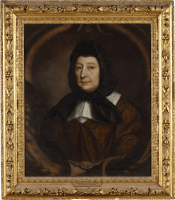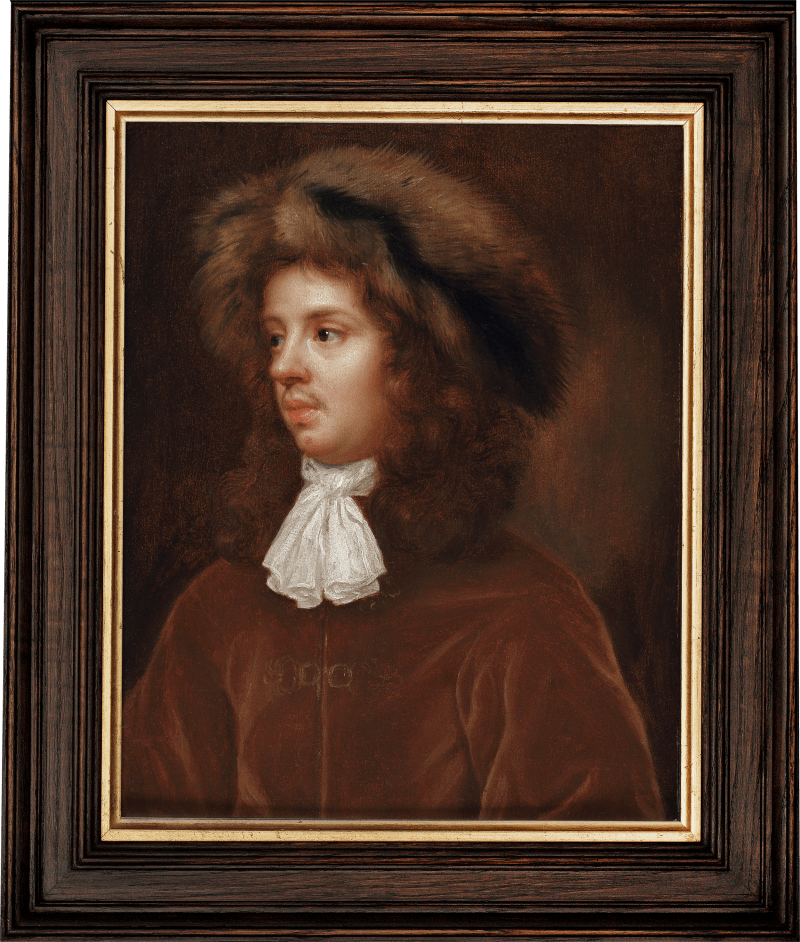We are grateful to Jacqui Ansell, dress historian, for her assistance when writing this catalogue entry.
Dressed in a black silk hood, this demure yet characterful sitter is Lady Anne Kingsmill (née Wroughton). When this portrait was taken, Anne was aged around 74 and had been widowed for fourteen years. Three sittings with ‘Lady Kingsmill’ are recorded in Charles Beale’s notebooks on 11, 14 and 22 May 1677.[1]
Legally, widows retained an interesting position in post-restoration England and enjoyed certain rights that most married women did not; they could own property, manage estates, and represent themselves in court. As a result, upper-class widows, such as Anne, might wield social and economic influence, managing substantial properties. Conversely, poorer widows often struggled economically, illustrating the era's distinct economic divides.[2]
The most striking feature of her dress is her headdress and, in this instance, the black pointed cap that peeks out at the sitter’s forehead is an indication of widowhood. We bear...
We are grateful to Jacqui Ansell, dress historian, for her assistance when writing this catalogue entry.
Dressed in a black silk hood, this demure yet characterful sitter is Lady Anne Kingsmill (née Wroughton). When this portrait was taken, Anne was aged around 74 and had been widowed for fourteen years. Three sittings with ‘Lady Kingsmill’ are recorded in Charles Beale’s notebooks on 11, 14 and 22 May 1677.[1]
Legally, widows retained an interesting position in post-restoration England and enjoyed certain rights that most married women did not; they could own property, manage estates, and represent themselves in court. As a result, upper-class widows, such as Anne, might wield social and economic influence, managing substantial properties. Conversely, poorer widows often struggled economically, illustrating the era's distinct economic divides.[2]
The most striking feature of her dress is her headdress and, in this instance, the black pointed cap that peeks out at the sitter’s forehead is an indication of widowhood. We bear the linguistic remnant of this item in the current term ‘widow’s peak’ for a hairline that recedes at each temple but forms a point in the centre of the forehead. The silk hood itself was both a functional and fashionable item, particularly appropriate for married women, and older women, who were often required to cover their hair in an act of modesty. Another key feature of mourning dress was the use of plain linen – as opposed to lace-trimmed garments – and the style of this sitter’s collar is akin to male collars of the 1670s, called ‘falling bands’ which extended down the front, as seen in the portrait of Sir William Turner.
This painting is included in Collins Baker's Lely and the Stuart Portrait Painters (1912), where Beale’s style is described as ‘feminine in execution and temper.’ [3] The notion of Beale's 'femininity,' purportedly evident or even 'intrinsic' in her artwork, has been a frequent theme throughout her historiography and is examined thoroughly in Tabitha Barber’s essay in the exhibition catalogue of Fruit of Friendship: Portraits by Mary Beale.
[1] Beale, ‘Notebook 1676/7’.
[2] Nickerson, R. (2018) ‘The Formidable Widow: Comparing the Representations and Life Accounts of Widows in 17th Century England.’, The General: Brock University Undergraduate Journal of History, 3, pp. 191-205.
[3] Baker, C. (1912) Lely and Stuart Portrait Painters. London: Philip Lee Warner, p. 40.













